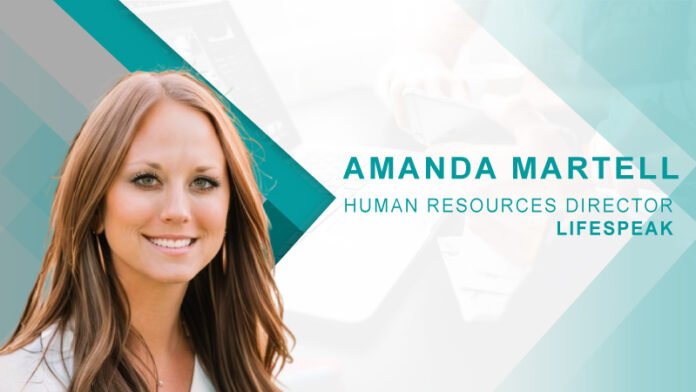As I grew into HR leadership positions, I became known for building scalable people programs, coaching leaders, and leading change during periods of growth and transformation. Today, as Director of HR, I bring a people-first, data-informed approach to shaping workplace culture, driving organizational effectiveness, and enabling teams to do their best work.
“A lot is changing in the world and the workplace right now, and people are feeling it. Employers are in a real position to help—starting with listening and making mental health support part of everyday life. HR teams can’t fix everything, but we can build cultures where people feel safe, seen, and supported.”
How are you seeing forward-thinking employers use early intervention and wellness programs to promote preventative care and reduce absenteeism?
The companies that are thinking ahead aren’t waiting for people to burn out before offering support. They’re building wellness into everyday life at work, so employees don’t have to hit a breaking point to get help.
That might mean giving people access to tools that help manage stress, sleep or physical health. Or, it might mean offering on-demand resources so employees can get support when they need it. The key is making it feel easy and normal to take care of your health.
When employees feel supported early, they’re more likely to stay healthy, miss fewer days and stay engaged. We’re seeing this with our data: over 90% of LifeSpeak users say they’ve needed fewer visits to doctors or therapists after using the platform. The other big shift is around flexibility. People are managing a lot at home, from caregiving to chronic conditions. When you give them options and trust them to choose what they need, it has a real impact.
Why is it essential for organizations to support women through menopause, and how does this impact talent retention, engagement, and equity in the workplace?
Menopause is one of the most common health transitions in the workforce, but for the longest time it’s been treated as a personal issue rather than a workplace one.
When women going through menopause don’t feel supported by their employer, it has negative effects on their confidence, focus, and ability to show up at work – not because they aren’t capable, but because their work environment isn’t set up to support them.
For organizations, this has real consequences: every year, unaddressed menopause symptoms cost US employers productivity loss worth $1.8B. Employers lose experienced talent, miss out on diverse leadership, and create equity gaps that could have been prevented.
The narrative around menopause needs to change. When women feel seen and supported through menopause, they’re more likely to stay engaged and contribute at their full potential in their roles. Offering flexible policies and access to expert support helps retain women at a critical career stage. It also sends a broader message that your workplace respects people’s health and life experiences — and not just the ones that are easy to talk about. Menopause is just as much a health issue as it is a culture and retention issue.
In your experience, what are some common challenges employees face when it comes to accessing mental health resources—and how can employers address these proactively?
A lot of employees don’t actually know what mental health resources are available to them. Benefits teams may be working hard to offer great support, but if people don’t hear about it in the right way — or at the right time — it doesn’t make a difference.
Another issue is stigma. Even when help is available, some people worry about judgment or confidentiality. They might not feel comfortable talking to their manager, or they’re unsure if using a resource could affect how they’re perceived at work.
That’s why communication matters. Employers need to talk about mental health often, in ways that feel relatable and safe. At LifeSpeak, we make it easy for organizations to share resources through campaign kits, so support isn’t hidden or hard to find. This is a good way to signal to people to be proactive about their mental health before they’re in crisis.
Confidentiality is also key. Employees need to know they can access support privately, without having to ask for permission or explain why. The more seamless and stigma-free you make it, the more likely people are to use it when it counts.
What can companies do year-round—not just during Pride Month—to support LGBTQIA+ employees with inclusive and psychologically safe mental health strategies?
It starts with recognizing that support can’t be seasonal. If your efforts only show up in June, people notice. Real inclusion means building trust every day, not just during Pride Month.
That includes offering mental health resources that reflect a range of identities and experiences. Representation matters; people need to see themselves in the experts, the language and the topics you make available. It also means giving people private, judgment-free ways to access support when they need it, without having to disclose personal details or go through a gatekeeper.
Policies and benefits matter, but culture also plays a huge role. Do people feel safe speaking up? Do leaders understand the impact of bias and microaggressions, even when unintentional? Psychological safety isn’t about getting everything perfect; it’s about creating an environment where people feel seen, respected, and are able to ask for help without fear.
And finally, listen to your LGBTQIA+ employees. Ask what’s missing. Ask what helps. Then act on what you hear. Inclusion is ongoing work that is built in the day-to-day.
How can HR leaders tailor mental health benefits and programs to meet the unique needs of different employee groups across life stages, identities, and job roles?
One of the biggest lessons we’ve learned is that mental health doesn’t look the same for everyone. What someone needs in their twenties might be completely different from what they need as a new parent, while caring for aging parents, or going through health changes later in life.
HR leaders can’t assume that a single resource will work for everyone. What helps is offering a range of support that people can access on their own terms. That could mean short videos on managing anxiety, or more in-depth guidance for navigating grief or burnout. Some people want to dive deep into a topic, while others just want quick, practical tips they can use right away.
It’s also important to think about job roles. A manager’s stress might come from team dynamics, while someone in a frontline role might be dealing with shift work, physical fatigue or financial strain. The more personalized and flexible the support, the more likely it is to be used.
We’ve found that when people can see themselves reflected in the resources, they are more likely to engage. That’s what helps build a culture where it feels safe to ask for help and take care of your mental health.
What role do HR leaders play in building a culture of openness and accountability around mental wellness in the workplace?
HR leaders play a big role in making mental wellness part of everyday culture. That starts with talking about it openly — including during town halls, onboarding and team meetings. The more we normalize these conversations, the safer people feel asking for help.
It’s also about making sure managers are both supported and equipped to support their teams. That means giving them tools to recognize when someone is struggling, and making it clear that wellbeing is part of their leadership role.
Overall, we need to look at how wellness shows up in day-to-day operations. Are we reinforcing healthy boundaries? Are workloads reasonable? Are leaders modeling the behavior we want to see? Internal communications play a big part here, too. Wellness messaging should show up year-round, not just during awareness months. Culture is shaped by what we say, what we fund, and what we do. HR leaders are in the critical position of making sure all three align.
What strategies or philosophies guide LifeSpeak’s approach to designing impactful solutions?
What guides our approach is the idea that people shouldn’t have to wait until they’re unwell to get support. We design solutions with the mindset that wellbeing should be part of everyday life, not something you only turn to when things go wrong.
We also recognize that health is deeply personal. What works for one person won’t work for another, so we build in choice. Some people want to learn from a medical expert. Others prefer a coach who speaks from lived experience. Some want to listen quietly during a commute, while others want to take action with a goal-based program. That variety is intentional.
Another guiding principle is access. We know that not everyone feels comfortable asking for help, or has the time to navigate complicated systems. So, we aim to remove barriers. Everything we build is meant to be simple to use, available anytime, and easy to trust.
To me, the real impact comes when support fits naturally into someone’s life. That’s when it gets used, and that’s what starts to shift the culture from reactive care to something much more proactive and long-lasting.
How can organizations better measure the effectiveness of their mental health and wellness programs beyond participation metrics?
To truly measure impact, you have to start with a baseline. What’s the current culture around mental health? What are people struggling with, and where are the gaps?
From there, it’s about tracking changes that matter — like whether employees feel more supported, whether stress levels go down, or if people are staying with the company longer. Participation helps, but it’s not enough on its own.
We’ve also found that feedback from employees goes a long way. When people say they’re using the tools to manage anxiety or avoid burnout, that’s a signal things are working. Culture change is harder to measure, but it’s often where you’ll see the biggest return.
What advice would you give to companies looking to create a more empathetic, equitable, and mentally healthy workplace?
Start by listening. Not just through surveys, but through conversations. Ask what’s getting in the way of people feeling supported or showing up fully, and be ready to hear things that are uncomfortable.
Building a more empathetic and mentally healthy workplace means creating a space where people feel safe speaking up, whether they’re struggling with stress, navigating identity-related challenges, or just trying to balance everything at once. Psychological safety isn’t a bonus feature; it’s the foundation.
Equity matters too. Not everyone has the same access to care or the same comfort level asking for help. Look at whether your programs meet people where they are. Do they reflect a range of lived experiences? Can someone access support without going through five layers of approval?
It also helps to look for creative ways to reinforce a culture of care. At LifeSpeak, we have quarterly “Take a Breath” days where the entire company is off at the same time. It’s a small thing, but it sends a clear message that rest is not only allowed, it’s encouraged. Those kinds of signals can shift a culture more than a policy ever could.
Finally, Amanda, what would you like to leave our readers with when it comes to the future of workplace mental health and inclusive care?
I’d say this: supporting mental health at work isn’t about big gestures. It’s about showing up for your people in real, consistent ways.
The future of workplace mental health will depend on whether we keep listening and responding to what people need. That means offering care that’s flexible, inclusive, and easy to access, no matter someone’s role, background, or where they are in life.
It also means making support part of everyday work. One leader in our company has a simple check-in during one-on-ones: “Are you green, orange, or red today?” It’s a low-pressure way to gauge how someone is doing. Not everyone will use the same language, but just asking with intention “How are you really?” can go a long way.
You don’t have to get everything right. But if your people see that you care, and that you’re paying attention, it makes a lasting difference. Choosing the right wellness partners, like ones who understand your people and help you meet them where they are, can make all the difference.

Amanda Martell Human Resources Director at LifeSpeak
Amanda Martell is the Director of Human Resources at LifeSpeak Inc., where she leads people strategy and workplace culture for a global provider of digital wellbeing solutions. With extensive experience across industries, she specializes in leadership development, employee relations, and inclusive benefits design.












